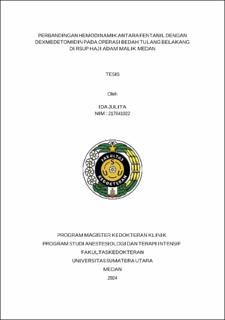| dc.description.abstract | Introduction: Spine surgery attracts the attention of anesthesiologists due to the
common perioperative issues, including fluctuations in blood pressure and
postoperative pain. Controlled hemodynamic can reduce intraoperative bleeding
and ensure clear visibility during the procedure. One technique to achieve
Controlled hemodynamic is the use of dexmedetomidine, which is the dextrorotatory
isomer of medetomidine and a highly selective agonist for alpha-2 adrenergic
receptors with significant activity towards alpha-1 adrenergic receptors.
Hemodynamic stability during spinal surgery is crucial to facilitate rapid recovery,
enabling early neurological assessment and more effective management of
complications.
Methods: This study is a double-blind randomized controlled trial conducted at
Haji Adam Malik General Hospital in Medan, involving 50 adult patients
undergoing elective spinal surgery. Patients were divided into two groups:
dexmedetomidine and fentanyl, using consecutive sampling techniques. Inclusion
criteria included patients aged 17–60 years with ASA physical status 1–3, while
exclusion criteria encompassed a history of hypersensitivity to the drugs,
anatomical heart abnormalities, and vascular disorders. Collected data will be
tabulated using SPSS, with numerical data presented as mean ± SD and categorical
data in frequency and percentage. Hypothesis testing will be performed using T-
tests or Wilcoxon tests, and normality will be assessed with the Shapiro-Wilk test,
with a p-value < 0.05 considered significant.
Results: The study showed that there was no significant difference in Mean Arterial
Pressure (MAP) and heart rate values between the two groups before induction
T0, with the dexmedetomidine group at 83.8 ± 12.58 and the fentanyl group at 85.7
± 13.11. However, after induction at minute 15, the MAP in the dexmedetomidine
group significantly decreased compared to the fentanyl group (p < 0.05). In the
pulse of both groups before induction (T0), there was no significant difference (P
> 0.005), but at minute 15 after induction, there was a significant difference, where
the pulse value in the dexmedetomidine group was lower compared to the fentanyl
group.
Conclusion: There is a significant difference in MAP and heart rate values between
the administration of dexmedetomidine and fentanyl during spinal surgery at RS
Adam Malik starting from 15 minutes after induction. The dexmedetomidine group
had lower MAP and heart rate values compared to the fentanyl group.
Keywords: Spine Surgery, Fentanyl, Dexmedetomidine, Hemodynamics. | en_US |


